Returning the Gods
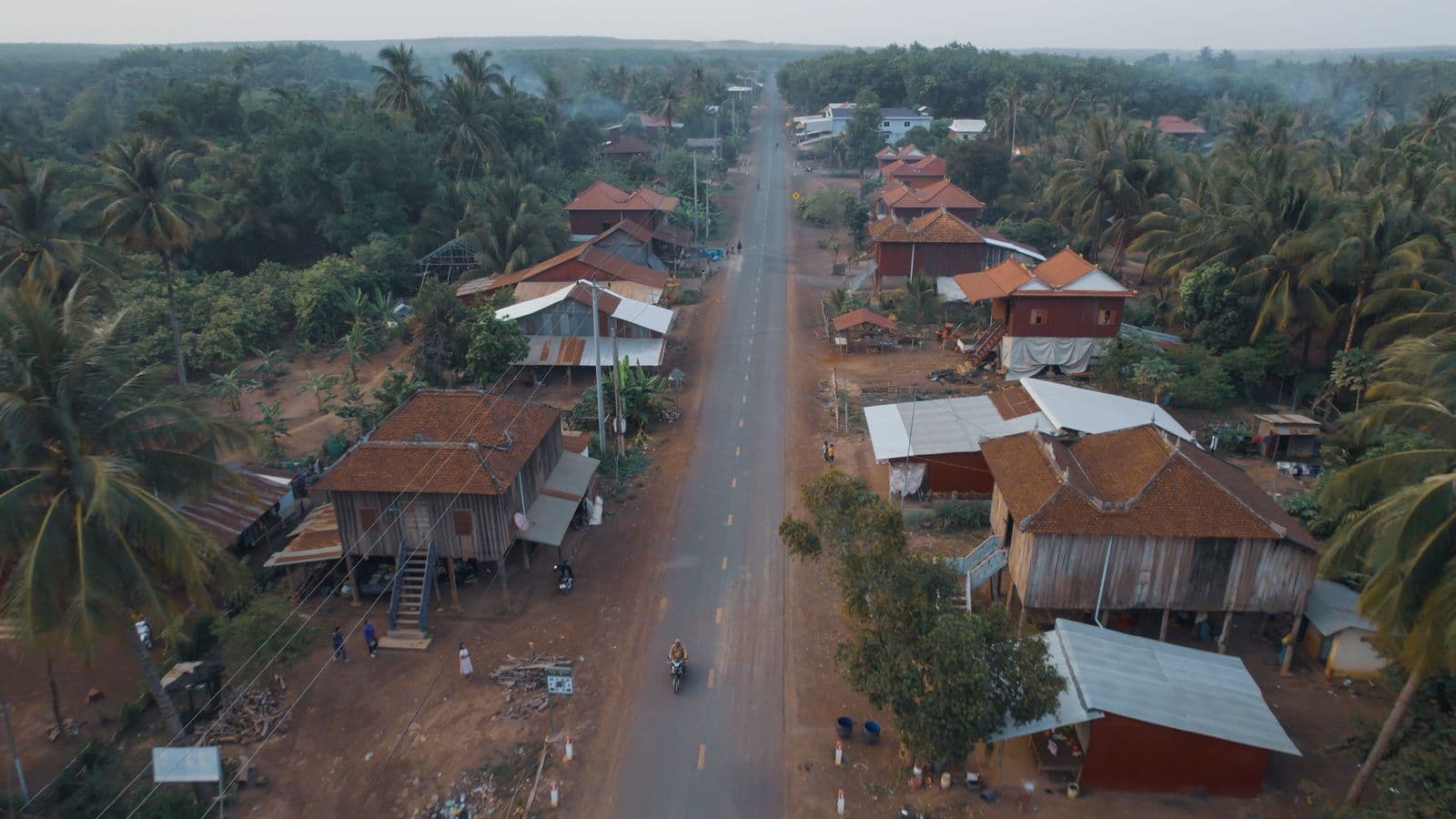
'The Falcon’ rides his bike through a village in Tboung Khmum province near where the group of Cham statues were looted in the 90s. Credit: ‘Foreign Correspondent’ ABC, Greg Nelson ACS
ANNE DAVIES reports on why three 1000-year-old Cham bronze sculptures are being repatriated to Cambodia.
It could be the plot of an Indiana Jones movie: an army of looters digging at night for buried treasure among temple ruins; priceless works of art smuggled through the jungle to Thailand; a disgraced dealer who profited from the thefts while simultaneously being feted as an expert in Asian art in the West; a daughter trying to make amends and a determined American lawyer working to restore a country’s heritage.
Australia’s connection to this extraordinary tale came to light when the National Gallery undertook one of its most extensive investigations into the provenance of a highlight of its Asian collection: Avalokiteshvara Padmapani, Vajrapani and Avalokiteshvara Padmapani, three 1000-year-old Cham bronze sculptures of bodhisattvas, or Buddhist saviours.
On 3 August the National Gallery announced that these masterpieces of Cham culture — which once flourished in an area spanning parts of modern-day Vietnam, Cambodia and Laos — would be returned to Cambodia, after it discovered they had been illegally excavated and exported. It was a bittersweet moment for the Gallery, which has spent almost a decade trying to unravel the truth about these invaluable works.
The sculptures were purchased by the National Gallery in 2011 for US $1.5 million from Douglas Latchford, a now-notorious British antiquities dealer who lived between Thailand and London and who was once regarded as one of the foremost experts in Khmer art. It was a fertile time to build a collection. A large number of high-quality artworks were emerging onto the market and the then director of the National Gallery, Ron Radford, wanted to see Australia build a world-class collection.
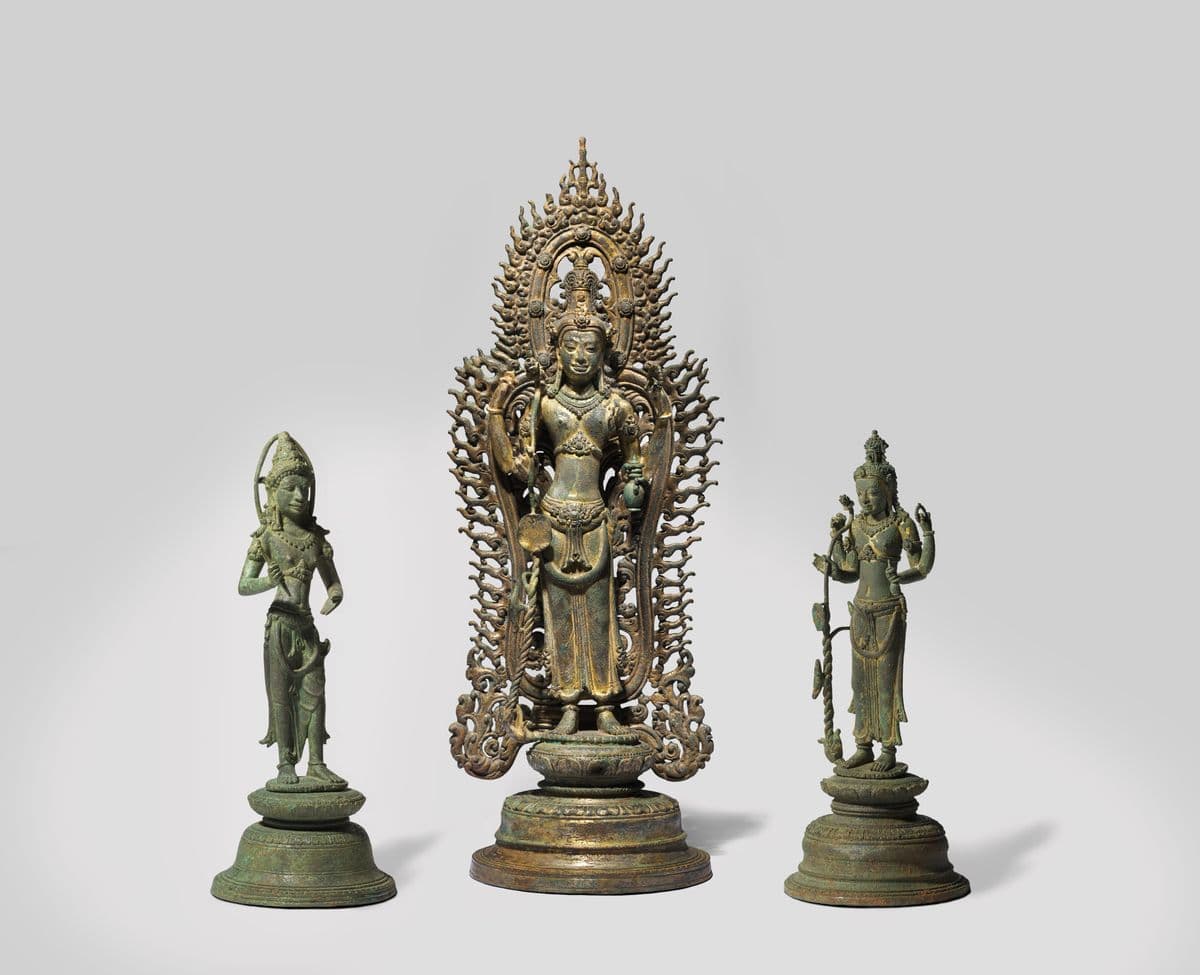
Champa Kingdom, Avalokiteshvara Padmapani, Vajrapani and Avalokiteshvara Padmapani, 9th–11th century, National Gallery of Australia, Kamberri/Canberra, Acquired 2011, deaccessioned 2021, repatriated 2023, On loan from the Kingdom of Cambodia, 2023–2026
The bodhisattva group was purchased directly from Latchford’s private collection, with Radford describing them in the annual report as ‘perhaps the most extraordinary work acquired this year’. With some of their gilding intact, the three intricate bronzes are extremely rare examples of Cham art and the main figure, in the words of one expert, ‘the most important Buddhist icon to be documented to date’.
Latchford provided a chain of ownership, but he also insisted on a confidentiality agreement which meant, until relatively recently, the National Gallery has been unable to say where it acquired the sculptures. According to the dealer, the works were originally bought in Vietnam in 1969 by an English businessman and collector, Ian Donaldson, who moved to Hong Kong around 1970. Donaldson sold the sculptures to Latchford in the 1970s, where they remained in his private collection until they were offered to the National Gallery in late 2010. At least that was the story. The reality was very different.
‘At the time of acquisition, a focus of the National Gallery’s Asian art collecting strategy was developing holdings of early Southeast Asian Buddhist art, especially works from the Cham kingdoms. Latchford, as with other dealers of Asian art, would periodically send curators photographs of works of art he had available that might align with the Gallery’s interests’, the Gallery’s Senior Curator, Provenance Bronwyn Campbell explained.1 ‘Some work was done on the provenance, but it was a deceased private collector. Donaldson died in 2001. Latchford said he bought it from him.’ The National Gallery did further due diligence, but as the purported prior owner was deceased and the sale had occurred decades earlier, it was unsurprising that no corroborating evidence was found. It was some comfort to the National Gallery, however, that another work formerly in Donaldson’s collection had been acquired from another dealer a few years earlier. The National Gallery also secured two informal expert opinions as to the work’s authenticity; established it was not on the art loss register; confirmed it was published in several texts; and obtained a warranty from Latchford. The ‘fact’ that the bodhisattva group was bought by Donaldson around 1970 was significant.
'But, barely a year after the National Gallery’s purchase of the Cham sculptures, the art world was rocked by scandal.'
In 1970, as wars ravaged Southeast Asia, parts of the Middle East and South America, a United Nations Educational, Scientific and Cultural Organization (UNESCO) committee drafted an international treaty, the Convention on the Means of Prohibiting and Preventing the Illicit Import, Export and Transfer of Ownership of Cultural Property. Signatories would agree to a number of measures including protecting their cultural property, honouring each other’s cultural heritage protection laws, requiring export certificates for art works, prosecuting those who traded in looted works and returning objects when they were found to be in breach of those laws. The Convention came into effect in 1972 and has been signed by 142 countries. The supposed 1970 export of the bodhisattva group predated laws that would have restricted its export from Vietnam, as well as the ethical line in the sand that museums the world over have observed for decades.
But, barely a year after the National Gallery’s purchase of the Cham sculptures, the art world was rocked by scandal. An American antiquities dealer, Subhash Kapoor, who ran a New York gallery, Art of the Past, was detained in Germany and extradited to India in July 2012 to face charges of theft and illegal export of art. Several major galleries, including the National Gallery, were caught up.

‘The Falcon’ shows ABC correspondent Mazoe Ford and the restitution team the spot where he dug up one of the Cham bronzes in the 90s. Credit: ‘Foreign Correspondent’ ABC, Greg Nelson ACS
The Gallery had acquired 22 works from Art of the Past, including a particularly fine Chola dynasty bronze Shiva as Lord of the Dance (Nataraja). The sculpture was seized by the Australian Government under the Protection of Movable Cultural Heritage Act 1986 at the request of the Indian Government and repatriated in 2014. The National Gallery has since removed all works of art acquired from Art of the Past from its collection. After a decade in prison in India, Kapoor was convicted in 2022 of stealing 19 ancient idols worth more than US $100 million. Further charges remain pending in New York.
There were also whispers about Latchford. In 2013 a private collector working with Sotheby’s and New York’s Metropolitan Museum of Art agreed to return works obtained via Latchford to their country of origin, Cambodia. In 2014 questions arose about another prized item in the National Gallery collection: a 2nd-century Kushan period Seated Buddha from northern India. The Gallery had bought it in 2007, from New York dealer, Nancy Wiener for US $1.08 million. It was alleged that Latchford was involved in creating a false provenance for a similar sculpture sold to a museum in Singapore, also by Wiener, and that this may also be the case for the National Gallery’s work. Unable to allay concerns, Wiener agreed to honour a guarantee she had given to the National Gallery and returned the money. Together, they donated the Seated Buddha to the Indian government.
In 2016 Wiener was charged with dealing in stolen antiquities, finally pleading guilty in 2021. The indictment referred to co-conspirator #1 who was widely believed to be Latchford — an associate of Wiener. By now, there were serious concerns about many Asian works of art in collections around the world, including in Australia. In 2015, former Justice of the High Court, Susan Crennan AC KC was brought in to advise on the question of provenance. The Cham bronzes were on the list of items to be reviewed. The reasons? Increasing concerns regarding Latchford, the shared provenance with the Seated Buddha, which had allegedly been in Ian Donaldson’s collection too, and a published reference to them being ‘unprovenanced’.
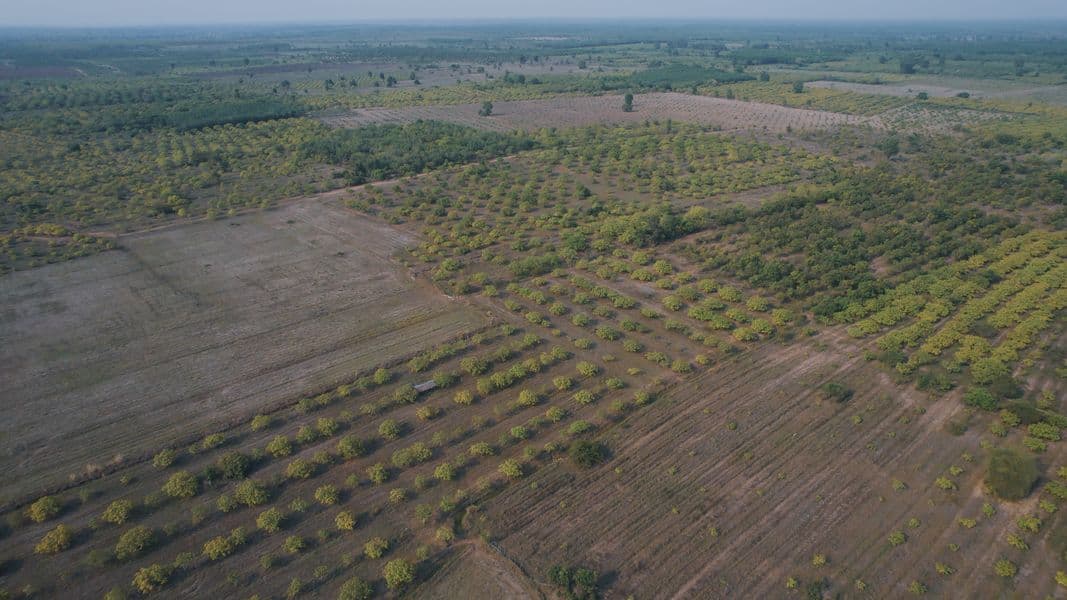
Fields in Cambodia’s Tboung Khmum province near where the group of Cham sculptures were looted in the 90s. Credit: ‘Foreign Correspondent’ ABC, Greg Nelson ACS
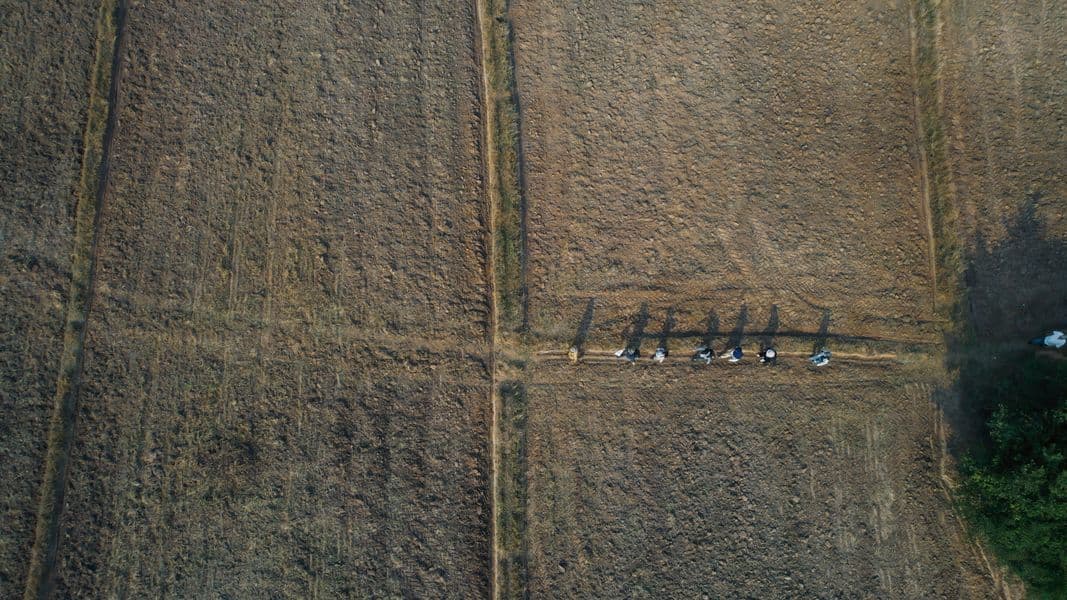
‘The Falcon’ leads ABC correspondent Mazoe Ford and the restitution team through the field to the spot where he discovered one of the Cham Bronzes in the 90s. Credit: ‘Foreign Correspondent’ ABC, Greg Nelson ACS
Over the years, research into the bodhisattva group has focused on two main lines of inquiry. The first was to try to establish the archaeological origins of the works, for example by consulting experts at L’École française d’Extrême-Orient in Laos, Vietnam and Cambodia, as well as the French head office, to ask if it held any records from scholars about these remarkable sculptures. Nothing. The second was to attempt to trace the sculptures backwards from their appearance on the art market in the 2000s by learning more about those whose hands they had (supposedly) passed through on their journey to Australia. Friends of Ian Donaldson were contacted, for instance. Most did not recall him having a special interest in Asian art, although one remembered him as a collector of luxury items, including some Cambodian pieces.
Meanwhile, Latchford’s life as a feted dealer in antiquities was unravelling. In 2019 he was indicted in a Manhattan court, which alleged he had engaged in an elaborate scheme to falsify the provenance of artefacts and charged him with wire fraud conspiracy by lying on invoices and shipping documents and about the nature of funds deposited into his US bank accounts to avoid an embargo on the import of Khmer cultural material into the United States. He died within months of being indicted, without having been arrested or tried.
‘I regret what I did,’ he said. ‘I want the gods to come home.’
An American lawyer, Bradley Gordon, has taken up the challenge on behalf of the Cambodian Government to claim back the nation’s cultural material, working with a team of Cambodian archaeologists, lawyers and researchers who hunt down the illicit origins of works of art in museums and private collections the world over, advocating for their return.
Gordon’s fascination with Cambodia began when, as a student, he was involved in helping Cambodian refugees in camps in Singapore and Thailand. After graduating from Harvard in 1995 he practised in New York before moving to Cambodia to set up his own practice. Convincing museums and collectors to return Cambodia’s cultural heritage has become a passion project that he undertakes pro bono.
In recent times, Gordon and his team have received assistance from an unusual source: Latchford’s daughter Nawapan Kriangsak. As her father became increasingly ill, Kriangsak began reviewing his papers and emails and found extensive evidence of his business dealings. She decided to make amends after his death, promising to return her father’s entire personal collection of more than 100 works of art to the Cambodian Government. In 2023 she returned 77 exquisite gold items referred to as ‘the crown jewels of the Angkor Empire’. She also settled a civil suit brought against the estate by the US Government, surrendering US $12 million and a 7th century Vietnamese bronze. Kriangsak has also provided Gordon and Cambodian authorities with the contents of her father’s computer and papers, a resource that has aided their pursuit of objects in museums and private collections.
As well as the information in Latchford’s files, Cambodia’s repatriation team has been aided by the testimony of former smugglers who have come forward to confess to their activities. Among them was Toek Tik, also known as Lion, a former Khmer Rouge child soldier who had commanded a 500-strong work team excavating and looting sculptures. Lion began excavating in the 1970s, as part of the Khmer Rouge’s efforts to fund the civil war that claimed thousands of lives and resulted in the genocide of Cambodia’s intellectuals. After the Khmer Rouge’s fall he kept up his activities.
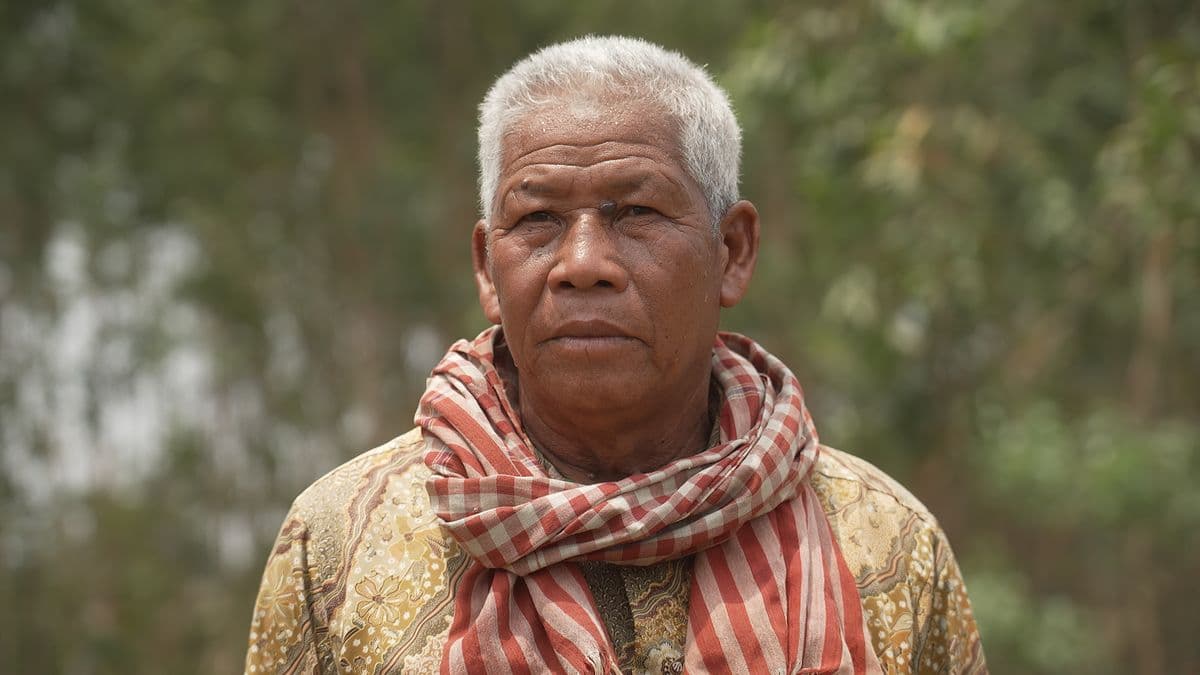
'The Falcon’ the former looter who dug up the Vajrapani bronze and is now assisting the restitution team. Credit: ‘Foreign Correspondent’ ABC, Greg Nelson ACS
In a video interview with The New York Times just before he died of cancer, Lion explained how he would take photos at temples and, through an intermediary, give them to a man known as Lord Ford, aka Latchford, who would then tell them what he wanted stolen. Under the cloak of night, the looters would hack the sculptures from their bases and transport them over the border to Thailand by bullock cart. Teams of men would also excavate the ruins, searching for buried sculptures with metal detectors and insider knowledge about grave sites or places used to secrete treasure when war loomed.
Lion’s accounts to Gordon and his researchers have proved critical in establishing where and when many priceless works of art were removed. He became a trusted source. In 2021 Lion’s testimony in a case brought by the US Attorney for the Southern District of New York resulted in the return, from a private collection, of Skanda on a peacock, one of the finest stone items from the tenth-century Khmer temples of Koh Ker. The authorities have been convinced, in part, by Lion’s ability to pinpoint the exact location of feet, bases and other remnants of statuary he says he once stole. In the interview Lion explained he was assisting authorities because he wanted to redeem himself before he died. ‘I regret what I did,’ he said. ‘I want the gods to come home.’2
Back in Australia, the National Gallery’s research on the Cham bronzes was inconclusive. A tangle of unsubstantiated anecdotes had left no clear picture of when the works had left their country of origin or certainty about which country they had come from. After learning of Kriangsak’s decision to return her father’s collection to the Cambodian Government in 2021, the National Gallery reached out to her. Researchers were put in touch with Gordon and his team and sent photos of the Cambodian and Khmer objects in the National Gallery collection, as well as of the Cham sculptures because of their connection to Latchford, although at the time it was believed that their most likely archaeological point of origin was Vietnam.
Almost immediately Gordon responded. Lion had recognised the bodhisattva group as sculptures that had been dug from a rice paddy in southern Cambodia, 20 kilometres from the Vietnamese border, in 1994. Lion recalled taking the artworks to Sisophon, Banteay Meanchey province, where they were illegally exported to Thailand by a man known as Sleeping Giant, who supplied cultural objects to Douglas Latchford and others. ‘This area of Cambodia is near the border of Vietnam, and what we learned from talking to the villagers is there had been some ancient battles in this area between Ankorian troops and the Chams and Viets,’ said Gordon. He continued:
'It’s part of the Ho Chi Minh trail, and it’s a fascinating place because you have layers and layers of history. There are quite a few temple structures, but it’s just the foundations. The local people understand or believe that the area was part of the Cham kingdom about 1000 years ago. We do know that in the 1700s parts of the royal family and the Cham kings fled to this part of Cambodia. So there are reasons why these treasures might have been here: either it goes way back in the early days of the Champa kingdom, or when the royal family returned.'
Gordon said Latchford’s files and computer records indicate that there might have been a couple of hundred Cham statues taken from this region and sold to museums and collectors. The story of the National Gallery’s Cham bronzes was corroborated by Falcon, the man who had overseen the excavation team at the local village. He, too, vividly recalled the find in November 1994. They had been using metal detectors and compass bearings to guide their digging at night near the ruins of temples. The two sculptures of the Bodhisattva Avalokiteshvara Padmapani were found together. The Bodhisattva Vajrapani, which is slightly different in style, had been found separately a small distance away, Falcon said. Gordon and his team have visited the site with the looters five or six times now to pinpoint the sites.
It’s likely the three sculptures found their way quite quickly to London after leaving Sleeping Giant’s hands, but there are conflicting and unverifiable narratives. The earliest confirmed public appearances of the works were in the early 2000s: the Vajrapani was offered for sale by a dealer who was close to Latchford in 2001, and the two Avalokiteshvara Padmapani sculptures were discussed in a 2004 talk by John Guy, now the curator of South and Southeast Asian art at the Metropolitan Museum of Art in New York. By 2007 the bronze sculptures were reunited as a trio. Latchford’s correspondence reveals that he was attempting to sell them to an American customer around this time.
One of the main concerns has been that the Cham culture spanned areas in modern-day Vietnam, Laos and Cambodia and the National Gallery had to be sure it was returning the sculpture to the correct government. The testimony uncovered by the Cambodian research team was the missing link. The three sculptures were removed from the collection in December 2021, pending final resolution of both the Gallery’s and Cambodia’s research.
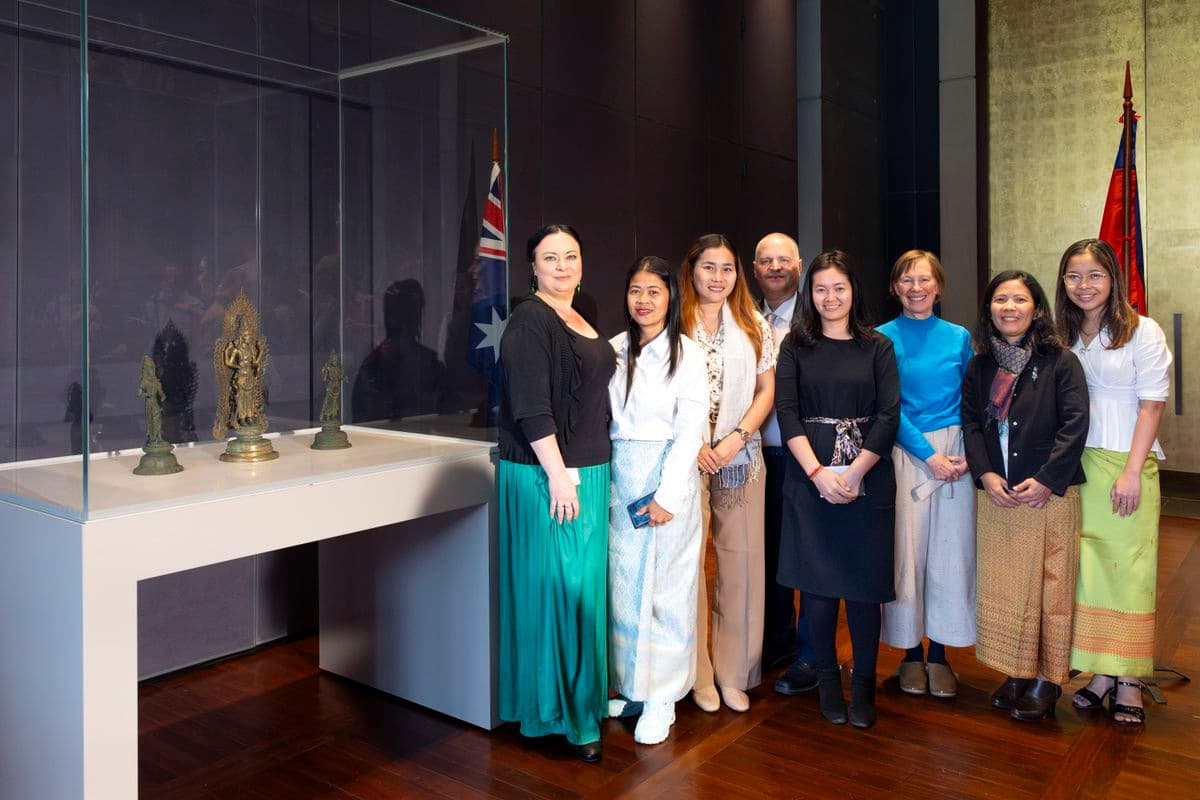
(left to right) Ms Bronwyn Campbell, Ms CHHOUN Kunthea, Ms MENG Vann Da, Mr Bradley Gordon, Ms TEK Soklida, Ms Carol Cains, Ms CHHOM Kunthea, and Ms POY Makara pictured with bodhisattva group, National Gallery of Australia, Kamberri/Canberra, 2023. Photo by: Karlee Holland.
An announcement that the bodhisattva group would be returned to Cambodia was made following a formal hand over to the Cambodian Government at a ceremony in Canberra. ‘The minister for culture is delighted for these to be returned’ said Gordon. The undersecretary of state from Cambodia’s Ministry of Culture and Fine Arts, Kong Vireak, declared: ‘Cambodia suffers a lot from the war. Our people have been traumatised and the return heals our nation.’
The good news is the public will have time to see the sculptures at the National Gallery before they travel to Cambodia. ‘We are discussing allowing them to stay in place for two or three years and bringing them home after that,’ said Gordon. ‘We are working on plans [for] upgrading the National Museum [in Phnom Penh] at the moment. All that will take time.’ The Gallery’s Director, Nick Mitzevich, said at the official handover that it was the first loan of a repatriated work of art the Cambodian Government had undertaken, calling it ‘a role model for greater cooperation’.
Avalokiteshvara Padmapani, Vajrapani and Avalokiteshvara Padmapani are on display in Worldwide, where they will remain for up to three years while the Cambodian Government prepares their new home in the kingdom's capital.
This story was first published in The Annual 2023.
- All Bronwyn Campbell quotes from a phone call between the author and Campbell, 7 June 2023.
- All Bradley Gordon quotes from a phone call between the author and Gordon, 16 June 2023.

